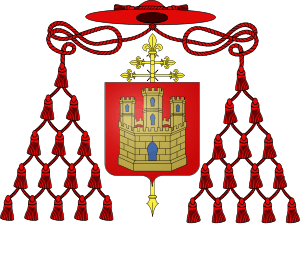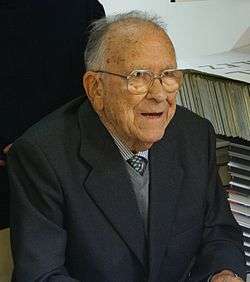House of Carrillo
The House of Carrillo is a Spanish noble house that traces its origins from the ancient Kingdom of Castile. There are several branches that exist such as Carrillo de Albornoz, Carrillo de Mendoza, Carrillo de Figueroa, Carrillo de Toledo and Carrillo Tablas among others. There are also several variations in spelling of the surname Carrillo such as "Carillo". Records prove that both surnames are one and the same.
History
Name origins
Carrillo is a Spanish surname, and reference to the family dates back to the Kingdom of Castile in the thirteenth century. According to a folkloric family origin legend, two brothers sharing royal bloodline accidentally killed a favorite courtier of their King, which forced them to flee into hiding to avoid his rage (it is said that the brothers dueled with the courtier over the honor of a beautiful Spanish maiden). The brothers eventually arrived in Spain after being placed under the protection of Count Fernán González of Castile.[1][2][3] (their country of origin is unknown). There they were so loyal to each other, they never left each other's side, and hence were called by the Castilians Carrillo, which is given several false etymologies: "loyal or devoted", implying that the brothers were very close one to another like the "carillon bells of the church towers", or comparing them to "two wheels on a cart". The brothers endeared themselves to the Castilians, and married two daughters of the Count. He gave them the titles of Count of Priego for the elder brother, and Marquis De La Guardia for the younger. All lines of the Carrillo family are said to branch from these two brothers. The name also appears in connection with an ancient Spanish legend concerning the Siete Infantes de Lara (Seven Princes of Lara).
The surname "Carrillo" is first found in Castile, Spain, in Burgos, Palencia, Soria, Logroño, Navarre, and Andalucia. Family members later went off to help in the conquest and establishment of colonies outside Spain, and included Cuba, Puerto Rico, Mexico, Venezuela, Costa Rica, Colombia, Chile, Philippines, Argentina, and the United States of America, particularly California.
Influence and service

The House of Carrillo frequently served the government through holding many offices and providing military leaders for Spain. Several prominent members of the house have been granted titles of nobility for services rendered to the state. The House of Carrillo has also produced three Catholic Cardinals, Cardinal Alonso de Carrillo Laso, Cardinal Alonso Carrillo de Albornoz and Cardinal Gil Alvarez Carrillo de Albornoz.
The most famous military leader produced by the House of Carrillo is José Carrillo de Albornoz, 1st Duke of Montemar who was Viceroy of Sicily. He victoriously lead the Spanish forces at the Battle of Bitonto. Because of his services, he was ennobled by King Philip V of Spain.
The Farce of Avila
Don Alfonso Carrillo, the Archbishop of Toledo, was said to have been the personification of intrigue. Jealous of the attention given to the Count Beltran de la Cueva, Carrillo headed the clique that went against King Enrique IV and was one of the people involved in the event known in history as the Farce of Avila. They later proceeded to take over the government by placing a dummy-King on the throne, proclaiming the Archbishop as Prince Alfonso. Carrillo was the main force in the matter and instigated the marriage of Prince Alfonso to Princess Isabel, later becoming the Princess’ spokesperson. But the tides soon turned against them and the Archbishop had to retreat from the affairs of court until his death.[4]
Prominent members
.jpg)

Below are some of the members and descendants of the House of Carrillo:
- Emperor Agustin I of Mexico, of the House of Iturbide; his mother was a member of the cadet branch of the House of Carrillo, Carrillo de Figueroa.
- Queen Fabiola of Belgium, Wife of Baudouin I of Belgium, descendant of the House of Carrillo
- Duke José Carrillo de Albornoz, 1st Duke of Montemar, victorious commander of the Spanish forces in the Battle of Bitonto and was made Duke of Montemar by King Philip V of Spain on April 20, 1735.
- Duke García Álvarez de Toledo, 1st Duke of Alba, Spanish nobleman, military leader and politician, son of Mencia Carrillo, Lady of Bercimuelle
- Marquis Luis de Benavides Carrillo, Marquis of Caracena, Governor of the Habsburg Netherlands (1659 and 1664), Governor of Milan, Spanish general and political figure.
- Marquis Diego Carrillo de Mendoza y Pimentel de Gelves, Viceroy of New Spain (Mexico)
- Marquis Alfonso de la Cueva, 1st Marquis of Bedmar, Spanish diplomat, bishop and Roman cardinal.
- Marquis Gastón de Peralta, 3rd Marquis of Falces, Spanish nobleman who was viceroy of New Spain
- Count José Baquíjano of Vista Florida, Spanish/Peruvian economist and jurist, writer and politician, and one of the first great intellectuals of the Viceroyalty of Peru.
- Don Luis Carrillo y Sotomayor, Knight of Santiago, Commander of the Spanish galleons and renowned Spanish poet [5]
- Cardinal Gil Alvarez Carrillo de Albornoz, (1310–1367), Spanish cardinal and Papal military leader
- Cardinal Gil de Albornoz, (1579-1649), Spanish Catholic Cardinal, Governor of the Duchy of Milan
- Archbishop Alfonso Carillo de Acuña, Spanish politician and Roman Catholic archbishop.
- Braulio Carrillo Colina, President (1835) and Dictator (1838–1842) of Costa Rica.
- Francisco Solano López Carrillo, President of Paraguay (1862-1870)
- Lieutenant General Antonio Ricardos Carrillo de Albornoz, fought against Habsburg Austria, the Portugal, and the First French Republic during a long military career. He invaded Rousillon where he won a series of victories over the French. After his death in early 1794, the war went badly for Spain.
- Captain José Antonio Carrillo, Alcalde of Los Angeles in 1826, 1828, and 1833.
- Don Manuel Carrillo Tablas, Alcade de Orizaba, Veracruz (1866–1867, 1871,1877, 1892-1894 & 1899-1900)and philanthropist of the City donating the lands of the present Cathedral of Orizaba, the Main Market among other properties and funded in large measure the Palace of Iron brought from Belgium and designed by Eiffel. Spanish noble arriving in Orizaba via Cuba.
- Don Jose Roberto Carrillo, was one of the first party of white men who entered California overland from Mexico in 1769 and considered one of the founding members of California.[6]
- Wenceslao Carrillo, prominent Spanish Socialist leader
- Santiago Carrillo, Secretary-General of the Communist Party of Spain
- Pedro Carrillo de Huete, Lord of Priego and Grand Falconer of John II of Aragon [7]
- Julián Carrillo Trujillo, Mexican classical composer, conductor, violinist and musical theorist
- Antonio Carrillo Flores, Mexican statesman and awarded by more than 23 governments
- Nabor Carrillo Flores, Mexican nuclear physicist and the lunar crater of "Carrillo" is named after him.
- Maestro Armando Ortega Carrillo, renowned Mexican Poet, Tenor, Composer and Conductor. Great grandson of Don Manuel Carrillo Tablas.[8]
- Don Jose Miguel Carrillo de Albornoz Muñoz de San Pedro, VII viscount of Torre Hidalgo. Lawyer. Spanish writer with several historic novels published and some biographies. Born in 1959.
- Don Victor Juni Carrillo, Married to Doña Eufrasia Paderanga Carrillo both Lived in Camiguin Island, Philippines Owner of Lands and Major Businesses, Holds its Trade to Spain, Germany and other European Countries through "Galleon Trade" Consider as Elite Family in the Island, A marker Honoring the Family is visible in the Old Spanish Church in Mambajao the capital town of the Island in "San Nicolas de Tolentino Parish"
- Zotico Tex Paderanga Carrillo, Secretary of Late President Ramon Del Fierro Magsaysay Philippines most favored President called as the "Man of the Masses" died in plane crash in 1955, Zotico luckily missed the flight due to traffic and save himself to the tragic event. He is a Journalist National and Local Newspaper, Economist, Educator and Politician
- Manuel Carrillo 3rd Born 9th of January 1997 lives in Houston Tx
- Mario Eulalio Carrillo of Tampico, Mexico, 1955 lives in San Antonio, Tx
- Don Juan Carrillo, Born Juan Antonio Carrillo, he was raised in the Little Mexico neighborhood of Las Vegas, east of Rancho Dr. and Washington Blvd. Don Juan has been described as a legend among men, others have described him as the devil incarnated because of his manipulation of others, as the devil takes many forms.
- David Carrillo, 1st Born, 4th of his name. Chemist lives in Santa Barbara, California.
References
- ↑ (Alberto y Arturo García Carrafa, 2003)
- ↑ (Nobiliario, Cardinal Alonso de Carrillo Laso)
- ↑ (Claros Varones, Hernán Pérez de Guzmán,)
- ↑ (Blasoneshispanos, 2003)
- ↑ (A. Costa: La obra poética de Luis Carrillo y Sotomayor (Córdoba, 1984))
- ↑ (Birmingham, 1986)
- ↑ J. de Mata Carriazo, ed. (1946). Crónica del halconero de Juan II. Madrid.
- ↑ Guzman, Daniel S.: El Sol de Orizaba, 13 de agosto de 2008.